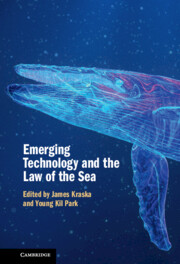Book contents
- Emerging Technology and the Law of the Sea
- Emerging Technology and the Law of the Sea
- Copyright page
- Contents
- Contributors
- Preface
- 1 Emerging Technology and Maritime Boundary Dispute Resolution
- 2 Renewable Energy and the Law of the Sea
- 3 Striking an Equitable Balance under the Biodiversity Agreement
- 4 Small Modular Reactors and Transportable Nuclear Power Plants
- 5 Shipping, Distributed Ledgers and Private Maritime Law
- 6 Maritime Cyber Security
- 7 International Standards for Hull Inspection and Maintenance of Robotics and Autonomous Systems
- 8 Functionalism and Maritime Autonomous Surface Ships
- 9 Artificial Intelligence to Facilitate Safe Navigation of Ships
- 10 Unmanned and Autonomous Warships and Military Aircraft
- 11 Seabed Technology and Naval Operations on the Continental Shelf
- Index
10 - Unmanned and Autonomous Warships and Military Aircraft
Published online by Cambridge University Press: 07 July 2022
- Emerging Technology and the Law of the Sea
- Emerging Technology and the Law of the Sea
- Copyright page
- Contents
- Contributors
- Preface
- 1 Emerging Technology and Maritime Boundary Dispute Resolution
- 2 Renewable Energy and the Law of the Sea
- 3 Striking an Equitable Balance under the Biodiversity Agreement
- 4 Small Modular Reactors and Transportable Nuclear Power Plants
- 5 Shipping, Distributed Ledgers and Private Maritime Law
- 6 Maritime Cyber Security
- 7 International Standards for Hull Inspection and Maintenance of Robotics and Autonomous Systems
- 8 Functionalism and Maritime Autonomous Surface Ships
- 9 Artificial Intelligence to Facilitate Safe Navigation of Ships
- 10 Unmanned and Autonomous Warships and Military Aircraft
- 11 Seabed Technology and Naval Operations on the Continental Shelf
- Index
Summary
Future naval and air forces will be comprised increasingly of unmanned and autonomous systems. Nearly 100 nations and nonstate actors currently operate unmanned and autonomous systems to support combat operations. These platforms have proven their ability to enhance situational awareness and improve mission performance. Unmanned systems will be used to augment manned platforms and will conduct missions that are considered dull, dirty and dangerous, thereby reducing risk to human life at a reduced cost. Introduction of these systems and vehicles will require states to modify how they characterize these platforms under international law as ships, warships, commercial aircraft and state aircraft to ensure that they are able to legally perform the missions that they have been designed to perform. This will require filling gaps in domestic and international law and regulations to better regulate and control the employment of these systems in the marine environment to ensure safety of navigation and overflight and protection of the marine environment.
Keywords
- Type
- Chapter
- Information
- Emerging Technology and the Law of the Sea , pp. 272 - 300Publisher: Cambridge University PressPrint publication year: 2022



